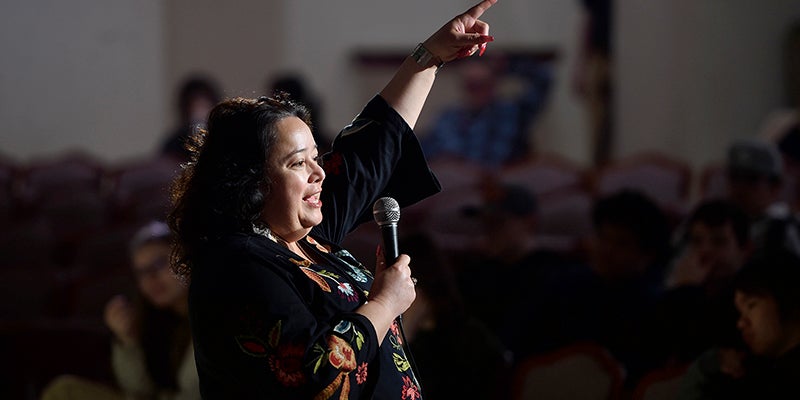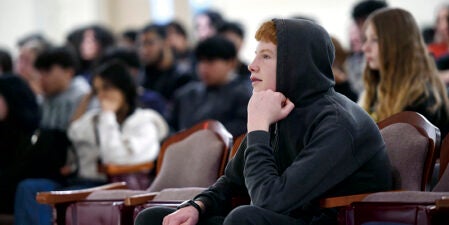Hands of our Future: Youth Institute gives AHS students a stake in food security
Published 7:00 pm Friday, March 22, 2024

- Tanya Rodriguez, Hormel Foods cultural anthropologist spoke to students at Austin High School earlier in March, highlighting the connection between art and food. Eric Johnson/photodesk@austindailyherald.com
|
Getting your Trinity Audio player ready...
|
Austin High School is taking part in a program it hopes will put the desire and ability for change in the hands of students.
Students in Lisa Sanders’ AP Human Geography Class are working toward Youth Institute, underneath the umbrella of the World Food Prize, a global initiative that looks at ways to solve food insecurity.
“This is the first year we’ve done it and we kind of selected a small group to get started because we wanted to see how the ins and outs of it were going to work,” said Austin Public Schools Gifted Services for Talent Development and Mentorship Coordinator Andrea Malo. “It just seems like a really good fit.”
Named in honor of Norman Borlaug, who was awarded the Nobel Peace Prize for his work in trying to solve hunger in India, the World Food Prize brings together people from all walks of life to share research around food insecurity and what is being done.
From that came the Youth Institute, which gives students the chance to become part of the solutions by adopting a country and researching food insecurity within the country’s borders with the aim of presenting viable solutions.
“There’s all kinds of different things students can look at, but a lot of them are tied back to the United Nations sustainability goals,” Sanders explained. “The students are working on researching what’s going on in their country, but also tying it to other things they’ve learned in terms of population size, family size and cultures in other countries.”
Once developed, then the students — around 40 out of the 50 students from the class — will go to the Youth Institute in the Twin Cities where they will present their plans to experts in the field as well as other students.
Some students will then be invited out of the Youth Institute to attend the World Food Prize held in Des Moines, Iowa in the fall. Students attending the Youth Institute will also be eligible for a $1,000 scholarship if they choose the University of Minnesota for their post secondary education.
“We wanted kids to have an authentic experience so they are really thinking that here’s a country in the world that has a problem and I, as a student, am going to share a reasonable solution that could be considered,” Malo said. “Really having the opportunity to sit, share ideas with others and listen.”
However, the project is also asking students to think outside of the box in relation to an often complicated subject.
Leading up to when the students submit their final papers on April 8, the students aren’t just coming up with solutions. Rather, it is a part of the overall impact they are being asked to consider.
“We have to think of things differently,” Sanders said. “Not necessarily that they don’t have food, but how could you possibly sustain yourself more as a country versus spending all of this money importing food from other countries.”
Partnering
with a company
The idea for Austin High School’s involvement in Youth Institute was brought to them by Hormel Food Corps, an active participant in the World Food Prize, and also is a partner in Austin’s Hometown Food Security Project.
Malo said that her and staff visited last year’s World Food Prize to get a better idea as to what it was all about and how it might fit with the school’s own plans.
Through Hormel, a number of people from the company have visited Sanders’ class and the school in general to talk about the impact of the World Food Prize and to impart their own experiences. Earlier in March, Tanya Rodriguez, Hormel Foods cultural anthropologist visited and presented to art students at Austin High School, who are working on their own projects regarding food insecurity.
Her topic demonstrated the correlation between art and food and how those kinds of connections can contribute to finding lasting answers to world hunger.
“Knowing that both food and art are the things that travel without needing language,” Rodriguez said. “You don’t need to even understand another person’s language to look at something, or hear something or taste something and have a relationship with those people.”
From her presentation, which demonstrated real life connections between the two mediums, Rodriguez said she hoped that the presentation imparted on students a sense of place within finding those answers to the problem.
“I want them to feel empowered,” she said. “I want them to understand their own power, their ability to have a voice, and speak that voice through another medium. Art gives them a way to express themselves.”
“I’m here and my food matters and how I think about food and how my culture thinks about food is different,” she added.
Seeing connection is an entwining thread for the company as it continues the work of outreach and connection. It’s close to the heart of Communications Manager of Global Impact for the company, Sneha Jogi.
She never had the opportunity to be a part of Youth Institute, but she was aware of it during her time in high school and as a member of FFA.
“My passion for food insecurity started when I was in high school and FFA,” Jogi said. “It’s what all my speeches were about.”
Growing up in the urban setting of Indianapolis, Jogi also had connections to the rural side of Indiana through her time with FFA. Through that dual familiarity, Jogi said she was able to experience both sides of the issue, an experience that sticks with her to this day
“I understand the rural side of America and was able to see a gap between the two,” she said. “I felt my role was to advocate for others and bridge those two gaps.”
Even though she missed out on Youth Institute, Jogi has been able to experience the World Food Prize while working with Hormel.
She said that attending the event last year left a lasting impression on her and strengthened her own determinations to continue contributing to the issue.
“It was really interesting going to the World Food Prize laureate event,” she said. “The whole event is about providing food security solutions both globally and in communities. Being in a space with people focused on solutions that are applicable align with the passions I have.”
It’s also provided a lens into further understanding the importance of involving youth through things like the Youth Institute. Having been one of those Hormel employees to visit the APS program this year has bolstered her confidence in a future that must involve the youth.
“I think it’s really important bringing youth to the table when creating solutions for food insecurity,” Jogi said. “At some point, they’re going to be sitting in the roles we have. The work they are doing is really crucial and I can see the spark in their eyes.”
A connection of community
Tammy Snee, advocate for the Hometown Food Security Project, sees the Youth Institute as not only a powerful connection for students to a larger problem, but also as a way to become leaders within the community.
“How can we get everybody working together?” Snee said. “That’s when I thought the World Food Prize Youth Institute would be a really interesting way to get the youth involved; to think about the problem, but also get involved in the community.”
Launched officially in 2022, the Hometown Food Security Project is seeking long term answers to food insecurity within the borders of Mower County, but at the same time it’s a mirror for the larger scale of the issue seen throughout the nation and across the planet.
By that mark, Snee thinks that Youth Institute can lay a foundation for by-in for students taking part this year and in the future.
“They take ownership of it,” she said. “When they see adults looking at them for answers and perspective, they feel confident saying what they think. They can think outside of that.”
Snee also said it can provide an easier path through difficult conversations.
“I think one thing it does is help normalize the conversation about the entire situation of food insecurity,” Snee said. “Not everybody stays in a food insecurity situation all of their life. Youth understand that it doesn’t define who they are.”
Running beneath all of it is a chance at unique education that students can rely on to open their eyes to an issue that touches on every country.
It was something that struck Snee immediately as an opportunity for Austin.
“I think for me, when I first started learning about it, I immediately wanted to bring it back to Austin to give our students the opportunity to be a part of the world,” Snee said. “It’s like one of those learning opportunities outside of the subject that makes them better students.”
But it also goes a little deeper than that. Solutions can go as far as a different perspective can take them.
“Their worlds are different from adults,” Malo said. “The kids may have a different view and perspective on it. Their insight is unique.”

“It may be providing students with an opportunity they haven’t had before. You guys don’t know where this could lead to. This might open other doors for you that you haven’t considered.”
Lisa Sanders, AP Human Geography teacher
Back to the classroom
Both Malo and Sanders envision a wide range of benefits for the students taking part in Youth Institute not only for the issue at hand, but also life outside of Austin High School.
The collective benefits of just being able to brainstorm, Sanders said, is a chance for students to not only have their ideas heard, but also listen to the voices of others.
“It may be providing students with an opportunity they haven’t had before,” she said. “You guys don’t know where this could lead to. This might open other doors for you that you haven’t considered.”
As the school looks at expanding the project in the coming years, Malo said that the idea of change is particularly appealing.
Realizing how difficult a problem food insecurity is may be a tough topic to tackle for students, but it also has the capability of leading to expanded student awareness.
“One of the hardest things is when you don’t have an answer,” she said. “There’s no right answer to this. There’s research you can do, but there’s no right answer and sometimes that can really stretch a student in their thinking because in school we’ve been taught many times there’s a right answer.”
And in Malo’s eyes there’s opportunity in that, not only for future endeavors and possible jobs, but possibly discovering also world-changing ideas.
“You never know how far it could go,” she said. “It’s truly an authentic experience for our kids to get this.”




